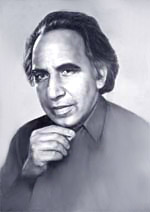 Balwant Gargi was a noted Punjabi playwright. He was born in Bhatinda. Balwant Gargi studied English literature and participated in theatre as a student. He taught acting and production in the USA in 1964-6. In 1968, he became the first director of the Department of Indian Theatre, Punjab University in Chandigarh. At that university he remained till 1976. He had a parallel career in cinema, producing Punjabi and Hindi serials, documentaries on Jatra and Ramlila, and also biographical films.
Balwant Gargi was a noted Punjabi playwright. He was born in Bhatinda. Balwant Gargi studied English literature and participated in theatre as a student. He taught acting and production in the USA in 1964-6. In 1968, he became the first director of the Department of Indian Theatre, Punjab University in Chandigarh. At that university he remained till 1976. He had a parallel career in cinema, producing Punjabi and Hindi serials, documentaries on Jatra and Ramlila, and also biographical films.
Gargi`s first play, Loha kutt i.e. `Blacksmith` in 1944 became controversial for its stark picture of the Punjab countryside. At that juncture, he focused on poverty, illiteracy, ignorance, and superstition marking rural life, which continued in Saelpathar i.e. `Petrified Stone` in 1949, Navan mudh i.e. `New Beginning` in 1950, and Ghugi i.e. `Dove` in 1950. In the 1950 edition of Loha kutt, he resorted to drawing poetic and dramatic elements from J. M. Synge and Garcia Lorca. In subsequent works like Kanak di balli i.e. `Stalk of Wheat` in 1968 and Dhuni di agg i.e. `Fire in the Furnace` in 1977, these became his chief vehicles. For all the specificity of native locale, the former deflected as much towards Lorca`s Blood Wedding as the latter reminded one of Yerma. In Mirza-Sahiban in 1976, customs and conventions came in for bitter censure. Gradually, Gargi`s preoccupation with sex, violence, and death became almost an obsession. Antonin Artaud`s theatre of cruelty grew into his categorical imperative. This required his dramaturgy to proceed through mythopoeia, which turns explicit in his last plays.
In Saunkan i.e. `Rival Women` in 1979, the paradigm of Yama-Yami, the Hindu god of death and his twin sister, becomes an occasion to glorify sexual union. Altogether dispensing with socio-political discourse, he turned to his new theme with a vengeance in Abhisarka i.e. `Lover` in 1990. His penchant for the unexpected grew all-powerful.
For subject matter Gargi moved freely over social milieu, mythology, history, and folklore. For form and technique he relied as much upon Sanskrit classics as on Lorca`s poetic drama, Brecht`s epic theatre, or Artaud`s theatre of cruelty. In the composition and performance of his dozen full-length plays and five collections of one-act drama, he traveled from the realistic to the mythopoeic mode. In addition to this dramatic corpus he has to his credit semi-autobiographical writings in English and the books Theatre in India in 1962 and Folk Theater of India 1966.




















